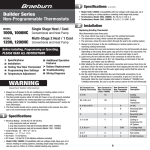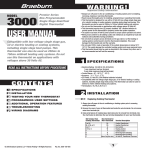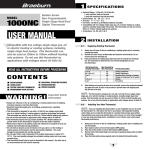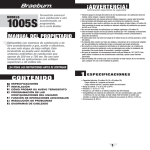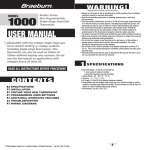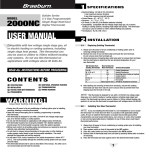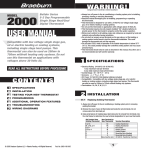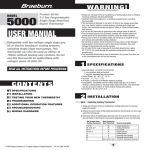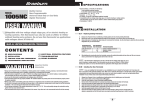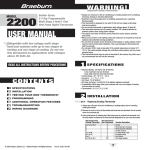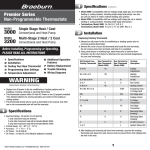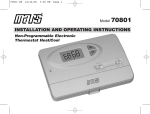Download Braeburn 1200NC Specifications
Transcript
1 Specifications cont. Builder Series Non-Programmable Thermostats MODEL 1000, 1000NC MODEL 1200, 1200NC Single Stage Heat / Cool Conventional and Heat Pump Multi-Stage 2 Heat / 1 Cool Conventional and Heat Pump Before Installing, Programming or Operating, PLEASE READ ALL INSTRUCTIONS 1 2 3 4 5 Specifications Installation Testing Your New Thermostat Programming User Settings Temperature Adjustment 6 Additional Operation Features 7 Battery Replacement 8 Troubleshooting 9 Wiring Diagrams WARNING Important Safety Information • Always turn off power to the air conditioning or heating system prior to installing, removing, cleaning or servicing thermostat. • This thermostat is a dual power thermostat and either requires 24 Volts AC Power or two (2) properly installed “AA” alkaline batteries for normal operation and control of the heating or cooling system. Refer to “Low Battery Detection and Replacement” section for more information. • This thermostat should only be used as described in this manual. Any other use is not recommended and will void the warranty. 1 Specifications • Electrical Rating: 24 Volt AC (18-30 Volt AC) 1 amp maximum load per terminal 2 amp total maximum load (all terminals) (Model 1000, 1000NC) 3 amp total maximum load (all terminals) (Model 1200, 1200NC) • Control Range: 45˚ - 90˚ F (7˚- 32˚ C) • Accuracy: +/- 1˚ F (+/- .5˚ C) • AC Power: 18-30 Volt AC • DC Power: 3.0 Volt DC (2 AA Alkaline batteries included) • Model 1000, 1000NC: Compatibility with low voltage single stage gas, oil or electric heating or cooling systems, including single stage heat pumps, can also be used on 250mv to 750mv millivolt heating only systems. • Model 1200, 1200NC: Compatibility with low voltage multi-stage gas, oil or electric heating or cooling systems, including multi-stage heat pumps. • Terminations, Model 1000, 1000NC: Rc, Rh, B, O, Y, W, G, C • Terminations, Model 1200, 1200NC: R, O, B, C, Y1, E/W1, G, W2 2 Installation Replacing Existing Thermostat 1. Always turn off power to the air conditioning or heating system prior to removing existing thermostat. 2. Remove the cover of your old thermostat and locate the wire terminals. Do not remove wires from terminals yet. 3. Using small pieces of masking tape, label wires prior to removal from terminals. Use the chart below to determine the new terminal designations for your new thermostat. New Terminal for New Thermostat (1200, 1200NC) Old Terminal from New Terminal for Existing Thermostat New Thermostat (1000, 1000NC) V or Rc Rc M, 4, Rh, or R Rh R, V-VR or VR-R B B R B O O O Y, Y1 or M Y Y1 E, H, W, or 4 W E/W1 G or F C, X or B G C G C Terminal Description Cooling Transformer Heating Transformer 24 VAC Reversing Valve (Heating) Reversing Valve (Cooling) Cooling or Compressor for HP System 1st Stage Heat or Emergency Heat Fan Control 24 VAC Common 4. After labeling and removing all wires from terminals, unscrew the existing thermostat sub-base from wall. Secure wires to prevent them from slipping into the hole in the wall. NOTE–MODEL 1000, 1000NC: This thermostat is designed for use with 24 Volt-AC low voltage single stage gas, oil or electric heating or cooling systems, including single stage heat pumps and can also be used on 250mv to 750mv millivolt heating only systems. Do not use this thermostat on applications with voltages above 30 Volts AC. NOTE–MODEL 1200, 1200NC: This thermostat is designed for use with 24 Volt-AC low voltage multi-stage gas, oil or electric heating or cooling systems, including multi-stage heat pump systems. Do not use this thermostat on applications with voltages above 30 Volts AC. 1 2 Installation cont. 2 Installation cont. Installing Your New Thermostat NOTE: If installing this thermostat in a new installation, locate the thermostat 4 to 5 feet above the floor in accordance with applicable building codes. Install the thermostat in a location that provides good airflow characteristics and avoid areas behind doors, near corners, air vents, direct sunlight or heat generating devices. Installation in these areas could impact thermostat performance. Wiring must conform to all building codes and ordinances as required by local and national code authorities having jurisdiction. 1. Turn off power to the air conditioning or heating system prior to installing thermostat. 2. Place system switch on front of thermostat to OFF position. 3. Place fan control switch on front of thermostat to AUTO position. 4. Remove front of thermostat body from sub-base by pressing release latch. 5. Place the thermostat sub-base against wall in the desired thermostat location. 6. Guide thermostat wires through hole in sub-base. Continue to hold against wall. 7. Mark placement of mounting holes as appropriate and drill using a 3/16" drill bit. 8. Gently tap supplied plastic anchors into the holes in the wall. 9. Place the thermostat sub-base against the wall in the desired location, making sure the mounting holes are aligned and the thermostat wires are inserted into the opening in sub-base. 10. Fasten sub-base to wall using supplied screws. 11. Connect wires to quick wiring terminal block using the new terminal designations. See section 7. 12. Make sure all of the wire connections are secure and not touching any other terminal to prevent electrical shorts and potential damage to the thermostat. 13. Turn the front thermostat body over, exposing the rear view of the circuit board. 14. Locate the internal ˚F /˚ C switch on the circuit board. Using your fingers, flip the switch toward the preferred temperature ˚F / ˚C scale. 15. Locate the internal fan option switch, HG (Gas) / HE (Elec) on the circuit board. This switch controls the heating system fan delay. Select gas for gas or oil fired systems. This will allow the furnace to run for a few seconds before initiating the fan. Select electric for systems with electric furnace elements that require the fan to come on immediately. Using your fingers, flip the switch toward HG (Gas) or HE (Elec). NOTE: For heat pump systems, the fan option switch should be set according to the second stage heating system type. 16. Locate the internal NORM / HP switch on the circuit board. This switch configures the thermostat for conventional (NORM) heating and cooling systems or heat pump (HP) systems. Using your fingers, gently flip the switch toward NORM or HP. 17. Attach front body of thermostat to sub-base of thermostat, being careful to align the terminal pins on the front body with the terminal block on the sub-base. 18. Open front thermostat door and open battery compartment door. 19. Install two new "AA" alkaline batteries. Locate the positive (+) ends of the batteries and match them with the positive (+) terminals located in the battery compartment. Close battery compartment. 20. Restore system power so you can test installation. 2 NOTE: If the thermostat was powered (batteries installed) prior to accomplishing steps 14 through 16, you will need to reset the thermostat to register thermostat switch configurations prior to programming any user settings. Gently press the RESET button on the front of the thermostat using a paperclip or a small pencil tip. NOTE – MODEL 1200, 1200NC: If the thermostat is configured for a conventional system and the system switch is in the EMER position, the unit will still function in a conventional 2 stage HEAT mode, but the display will flash NO AUX SET. 3 Testing Your New Thermostat WARNING! Read BEFORE Testing • Do not short (or jumper) across terminals on the gas valve or at the heating or cooling system control board to test the thermostat installation. This could damage the thermostat and void the warranty. • Do not select COOL mode if the outside temperature is below 50˚ F (10˚ C). This could damage the controlled cooling system and cause personal injury. • This thermostat includes an automatic compressor protection feature to avoid potential damage to the cooling system from short cycling. This thermostat automatically provides a 5-minute delay after turning off the cooling or heating system output to protect the compressor. NOTE: Test your thermostat prior to programming any user settings. Pressing the RESET button will erase any user entries previously programmed and return them to their default values. 1. Place the system switch in the HEAT position. 2. Press the button on the keypad until the set point temperature setting is a minimum of 3 degrees higher than the current room temperature. The heating system should start within several seconds. The fan may not turn on immediately due to the heating system built-in fan delay. 3. Place the system switch in the OFF position. The heating system should stop within several seconds with conventional heating or cooling systems. On heat pump systems you must wait 5 minutes for the automatic compressor short cycle protection period to expire, or press the RESET button to bypass this feature for initial testing purposes. Pressing the RESET button will erase any user program settings. 4. Place the system switch in the COOL position. 5. Press the button on the keypad until the set point temperature is a minimum of 3 degrees lower than the current room temperature. 6. The cooling system should start within several seconds. Place the system switch in the OFF position. The cooling system should stop within a few seconds. 7. Place the fan switch in the ON position. The system blower should start. 8. Place the fan switch in the AUTO position. The system blower should stop. 3 4 Programming User Settings Setting Second Stage Differential Default Thermostat Settings Function 4 Programming User Settings cont. Status After Reset Operation Mode Normal Operating Mode Room Temperature 70˚ F (21.0˚ C), to be renewed within 5 seconds Set Point Temperature According to system switch Heat or Off: 62˚ F (17.0˚ C) Emergency Heat (1200 and 1200NC only): 62˚ F (17.0˚ C) Cool: 85˚ F (29.0˚ C) Temperature Scale ˚F or ˚C dependent on switch setting Low Battery Warning Off, to be renewed within 5 seconds. Off if 24V is present 1st Stage Differential 0.5˚ F (0.25˚C) 2nd Stage Differential 2˚ F (1.0˚ C) Short Cycle Protection Timer Reset Output Relays Off The default setting is 2˚ F (1.0˚ C). The room temperature must change 2˚ F (1.0˚ C) in addition to the first stage differential setting before the thermostat will initiate the second stage of the system in heating. 3. Press and hold the and buttons at the same time again and the LCD display will show "SET D2 x˚", where "x" equals the ˚F / ˚C differential setting. This is the current second stage differential setting. 4. Press the or buttons to set the second stage differential to your desired setting of 2˚, 3˚, 4˚, 5˚ or 6˚ F (1˚, 1.5˚, 2˚, 2.5˚ or 3˚ C). NOTE – MODEL 1200, 1200NC: Once you have finished setting the second stage differential, you can wait 5 seconds and the thermostat will return to the normal operating mode. Or you can press both the and buttons at the same time to return to normal operating mode. NOTE: To erase all user program settings, gently press the RESET button using a paper clip or a small pencil tip. This will return all thermostat settings to their default values, erasing all program settings entered by the user. Setting Temperature Differentials The default settings for the first and second stage differentials are compatible with most systems and applications. This is normally set at time of installation and usually does not require any modification under normal operating conditions. If you feel that your system is turning on too often, simply follow the instructions below. NOTE: The first and second stage differential settings are the same for both the heating and cooling systems. Setting First Stage Differential The default setting is 0.5˚ F (0.25˚ C). The room temperature must change .5˚ F (0.25˚ C) from the set point temperature before the thermostat will initiate the system in heating or cooling. 1. In normal operating mode, press and hold the and buttons at the same time for 3 seconds. LCD display will show "SET D1 x˚", where "x" equals the ˚F / ˚C differential setting. This is the current first stage differential setting. 2. Press the or buttons to set the first stage differential to your desired setting of .5˚, 1˚, or 2˚ F (.2, .5˚ or 1.0˚ C). NOTE–MODEL 1000, 1000NC: Once you have finished setting the first stage differential, you can wait 5 seconds and the thermostat will return to the normal operating mode. Or you can press both the and buttons at the same time to return to normal operating mode. NOTE–MODEL 1200, 1200NC: If you do not wish to change the second stage differential, you can wait 5 seconds and the thermostat will automatically return to the normal operating mode. Otherwise, you can press both the and buttons at the same time to return to normal operating mode. 4 5 Temperature Adjustment NOTE: This thermostat has separate heating and cooling set points, which can be reviewed or changed by selecting either HEAT or COOL with the system switch. Review Set Temperature 1. Press and hold the or button. The current set point temperature will be displayed in place of the current room temperature, and the indicator SET will be displayed. 2. The display will return to normal operating mode when the or buttons are released. The SET indicator will turn off, indicating that the current temperature shown in the display is the room temperature. Changing Set Temperature 1. Press and hold the or button for more than 1 second. The entire display will flash once and the SET indicator will be flashing. Release the or button and press the or button again to adjust the set temperature. 2. The display will return to normal operating mode after 5 seconds, or you can press both the and buttons at the same time to return to normal operating mode. 3. The SET indicator will turn off in the display, indicating that the current temperature shown in the display is the room temperature. 5 6 Additional Operation Features 6 Additional Operation Features cont. Compressor Protection Feature Status Indicators This thermostat includes an automatic compressor protection feature to avoid potential damage to the system from short cycling. This thermostat automatically provides a 5-minute delay after turning off the cooling system output to protect the compressor. This protection is also present in the heat mode of operation on heat pump systems to protect the compressor. HEAT: This will turn on whenever the system switch is in the HEAT mode. “HEAT” will flash when the heating system is running. NOTE: The installer can bypass the compressor protection feature by pressing the RESET button. This will erase all user program settings, returning all settings to their default values. This should only be used during installation for testing purposes or to reset a thermostat to regain normal operation. Low Battery Detection and Replacement This dual power thermostat requires two (2) new, properly installed “AA” Alkaline batteries to provide proper thermostat power when 24 volt AC power fails or is not connected to the thermostat. When the batteries start to become too weak to provide proper operation, the thermostat will begin to display a 3 stage low battery indicator. Low Battery Stage Battery Indicator AUX (Model 1200 and 1200NC Only): This will turn on when the auxiliary (second stage) of heating is active. The auxiliary stage of heating is usually the least economical stage of heat and typically runs when the first stage of heat cannot keep up with the temperature demand. COOL NOTE: AUX is also displayed when the system switch is in the Emergency (EMER) Mode. Duration Action Stage 1 Solid 0-30 Days Replace Batteries as Soon as Possible. Stage 2 Flashes Every 2 Seconds 31-60 Days Replace Batteries Immediately to Provide Proper Operation. Stage 3 Flashes Every 1 Second 61-90 Days Replace Batteries Urgently to Provide Proper Operation. The 3 stage low battery indicator is provided to inform the user when the batteries require immediate attention. We recommend replacing the batteries as soon as the low battery indicator appears. If the batteries are not replaced after the low battery indicator first appears, the thermostat may not provide proper heating or cooling system operation. Even if the low battery indicator does not appear, the batteries should be replaced at least once a year, or if you plan on leaving the premises for over a month. This dual power thermostat can be powered from 24 volts AC or battery power. To determine if 24 volt AC power is connected to the thermostat, refer to the installation and wiring diagram section. If you cannot determine how this thermostat is powered, call a professional service technician to determine the type of installation and the proper operation of your system. Non-Volatile Memory In the event of a power failure, the Non-Volatile Memory feature allows all settings to be recovered, eliminating the need to reset temperature and differential settings. When AC power is restored after an outage or batteries are reinserted, all settings are retrieved from memory and reinstated. 6 COOL: This will turn on whenever the system switch is in the cool mode. “COOL” will flash when the cooling systems is running. 7 Battery Replacement Replacing the Batteries 1. Open front cover and locate the battery compartment door. 2. Gently remove the two "AA" alkaline batteries located in the battery compartment. 3. Install two new "AA" alkaline batteries into battery compartment. Make sure to match the positive (+) ends of the batteries with the positive (+) terminals located in the battery compartment. 4. Close battery compartment. The low battery indicator should not appear in the display. 8 Troubleshooting Symptom: Thermostat does not turn on heating or cooling system. Potential Solution: Check to see if OFF is shown in display. This indicates that the system is turned off at the thermostat. Move system selector switch to HEAT or COOL position. After the compressor short cycle protection 5-minute period expires, the system should start. Compressor protection feature may be in effect due to compressor short cycle conditions. See Section 6. Heating or cooling system may be malfunctioning. Call a professional service technician immediately to verify system operation. Symptom: Thermostat turns on heating instead of cooling, or cooling instead of heating. Potential Solution: Check thermostat wiring to make sure the heating and cooling stages are connected to the correct terminals on the wiring block. See Section 9. Symptom: Thermostat turns heating or cooling system on too often or not often enough. Potential Solution: Increase or decrease temperature differential settings as appropriate to provide the desired performance level. See Section 4. Symptom: Low battery indicator is blinking in thermostat display. Potential Solution: Replace batteries immediately to maintain proper system operation. See Section 7. 7 8 Troubleshooting cont. Symptom: Thermostat display is blank. Potential Solution: It is possible that AC power is not present at the thermostat, and/or the batteries are drained. Check fuse, circuit breaker and thermostat wiring as appropriate to verify AC power is available. Replace batteries before reprogramming thermostat. See Section 7. If AC power is present, call a professional service technician to verify thermostat and system performance. Symptom: HI is shown in the thermostat display. Potential Solution: The temperature sensed by the thermostat is higher than the 99˚ F (37˚ C) upper limit of the thermostat’s display range. The display will return to normal after the sensed temperature lowers within the 40˚ to 99˚ F (4˚ to 37˚ C) display range. Turn on the cooling system or use other methods to lower the temperature accordingly. Symptom: The room is too warm or too cold. Potential Solution: See Section 5. Review current set point and change as necessary. Symptom: HEAT or COOL is flashing, but the system is not running. Potential Solution: The thermostat is telling the heating or cooling system to run, but the system is not responding. You may need to call your local heating and air conditioning contractor. 9 Wiring Diagrams MODEL 1000, 1000NC: Single Stage Conventional Systems (Single Transformer) Rc Rh B O Cool Control 8 C Fan Control Neutral 120 VAC Hot NOTES: 1. Transformer common not required for battery-only operation of thermostat. 2. For heating or cooling only system, ignore opposite connection. 3. For 2-wire 24 Volt AC or 250 mV - 750 mV millivolt heating systems, ignore cooling connection and fan control. MODEL 1000, 1000NC: Single Stage Conventional Systems (Dual Transformer) Rc Rh B Remove Factory Installed Jumper This condition could occur from the system being turned off during a cold weather period or upon installation when the thermostat has been stored for a long period of time in a cold vehicle or location prior to being installed. The thermostat should be allowed to warm up prior to installation to allow proper heating control once installed. Symptom: Fan continues to run whether the system is on or off. Potential Solution: Check that the fan control switch is in the AUTO position. This will allow the fan to run only when the heating or cooling system is turned on and running. Check thermostat wiring to make sure that the fan control wiring is connected to the correct terminals on the wiring block. See Section 9. G 24 VAC Symptom: NO AUX SET is shown in the thermostat display. (model 1200 and 1200NC only) Potential Solution: The thermostat (model 1200 and 1200NC only) is configured for a conventional system, and the system switch is in the EM HEAT position. The unit will still function in a conventional 2 stage HEAT mode, but the display will flash NO AUX SET. Move the system switch to the HEAT position. Symptom: Cannot program a set point temperature higher than 90˚ F (32˚ C). Potential Solution: This is above the normal thermostat temperature setting range of 45˚ to 90˚ F (7˚ to 32˚ C). W Heat Control This condition could occur from the system being turned off during an exceptionally warm period or upon installation when the thermostat has been stored for a long period of time in a warm vehicle or location prior to being installed. Symptom: LO is shown in the thermostat display. Potential Solution: The temperature sensed by the thermostat is lower than the 40˚ F (4˚ C) lower limit of the thermostat’s display range. The display will return to normal after the sensed temperature rises within the 40˚ to 99˚ F (4˚ to 37˚ C) display range. Turn on the heating system to raise the temperature as needed for comfort within the room. Y Factory Installed Jumper O Y W G Heat Control Cool Control Neutral Fan Control C Transformer Common (See NOTE) Symptom: OFF is shown in thermostat display and heating or cooling system will not start. Potential Solution: This indicates that the system is turned off at the thermostat. The thermostat must be in HEAT or COOL mode of operation to control the heating or cooling system. Move the system selector switch to the HEAT or COOL position. Transformer Common (See NOTE 1) 8 Troubleshooting Neutral 24 VAC 120 VAC 120 VAC 24 VAC Hot Hot Heating NOTE: Cooling Transformer common not required for battery-only operation of thermostat. 9 9 Wiring Diagrams cont. B Factory Installed Jumper O Y W Reversing Valve (Active in Cooling - See NOTE 2) Compressor Control Reversing Valve (Active in Heating - See NOTE 2) R C G Fan Control Transformer Common (See NOTE 1) Rc Rh cont. MODEL 1200, 1200NC: Multi-Stage Heat Pump Systems MODEL 1000, 1000NC: Single Stage Heat Pump System O B Reversing Valve (Active in Heating - See NOTE 3) Reversing Valve (Active in Cooling - See NOTE 3) C Y1 Transformer Common (See NOTE 1) 9 Wiring Diagrams G E/W1 Emergency Heat Control 1st Stage Compressor Contact W2 2nd Stage Heat Control Fan Control Neutral Neutral 120 VAC 24 VAC 24 VAC Hot NOTES: 1. Transformer common not required for battery-only operation of thermostat. 2. For units requiring reversing valve to be energized during heating, connect reversing valve to B terminal. For units requiring reversing valve to be energized during cooling, connect reversing valve to O terminal. B C (See NOTE) Transformer Common O Y1 E/W1 G 1st Stage Heat Control 1st Stage Compressor Control NOTES: 1. Transformer common not required for battery-only operation of thermostat. 2. Jumper is required to use Auxiliary Heat for both Second Stage and Emergency Heat on units without separate Emergency Heat and Auxiliary Heat terminals. 3. For units requiring reversing valve to be energized during heating, connect reversing valve to B terminal. For units requiring reversing valve to be energized during cooling, connect reversing valve to O terminal. W2 2nd Stage Heat Control Fan Control Neutral 24 VAC 120 VAC Hot NOTE: Transformer common not required for battery-only operation of thermostat. 10 120 VAC Hot MODEL 1200, 1200NC: Conventional Systems (Single Transformer) R See NOTE 2 11 1000 Series Thermostats LIMITED WARRANTY STORE THIS BOOKLET FOR FUTURE REFERENCE MODEL 1000, 1200: 5 YEAR LIMITED WARRANTY MODEL 1000NC, 1200NC: 2 YEAR LIMITED WARRANTY Braeburn Systems LLC warrants each new Braeburn thermostat against any defects that are due to faulty material or workmanship. This warranty and our liability does not apply to batteries, nor does it include damage to merchandise or the thermostat resulting from accident, alteration, neglect, misuse, improper installation or any other failure to follow Braeburn installation and operating instructions. This limited warranty applies for the duration of the warranty period from the original date of purchase by a professional service technician. Braeburn Systems LLC agrees to repair or replace at its option any Braeburn thermostat under warranty provided it is returned postage prepaid to our warranty facility in a padded carton within the warranty period, with proof of the original date of purchase and a brief description of the malfunction. This limited warranty does not include the cost of removal or re-installation. This warranty gives you specific legal rights and you may also have other rights that vary from state to state or province to province. Answers to any questions regarding our limited warranty may be obtained by writing our corporate offices. WARRANTY FACILITY: Braeburn Systems LLC Attn: Warranty Department 2215 Cornell Avenue Montgomery, IL 60538 Braeburn Systems LLC 2215 Cornell Avenue • Montgomery, IL 60538 Technical Assistance: www.braeburnonline.com Call us toll-free: 866-268-5599 (U.S.) 630-844-1968 (Outside the U.S.) ©2009 Braeburn Systems LLC • U.S. Patents D530,633; D527,658; 7,438,469 • All Rights Reserved. Made in China • 1000-100-010







